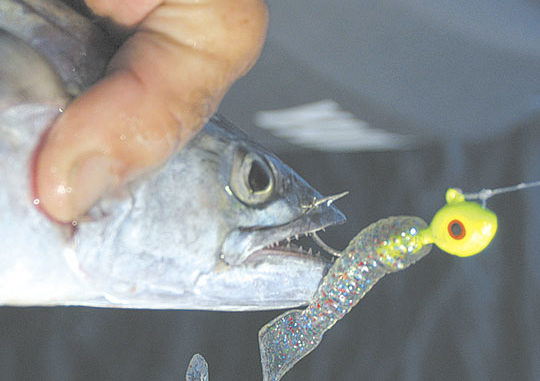
Hatteras anglers get to sample the great fall run of these hard-charging fish this month.
When anglers hear the word “Hatteras” mentioned in the same sentence with the word “fishing,” the first species that cross their minds are probably red drum or channel bass, speckled trout, blue marlin, yellowfin tuna and bluefish.Those are the fish that have helped give the tiny Outer Banks fishing village the nickname “Fishing Capital of the World.”
Way down the list is Spanish mackerel, not because the fishing isn’t great just off the thin strip of sand that separates the Atlantic Ocean from the Pamlico Sound, but because, well, you can catch Spanish mackerel just about anywhere along the North Carolina coast — you don’t have to go to Hatteras to find them.
However, more and more anglers who find themselves heading south out of Nags Head on Rt. 12 are realizing that although overlooked, the fall run of Spanish mackerel out of Hatteras Inlet might match anybody else’s fishing, anytime. It’s just a matter of putting off those other species long enough to concentrate on the “prince” mackerel.
That’s the situation Ken Dempsey and Scott Caldwell find themselves in each autumn. The two inshore fishing guides have come to understand in the fall, a couple dozen Spanish mackerel go a long way to making their parties happy — in addition to the trout and puppy drum and flounder that generally make their way into the cooler.
“The last few years, I’ve been doing more and more mackerel fishing,” said Caldwell, who operates Coastal Inshore Charters at Teach’s Lair Marina in Hatteras. “The older I get, it seems like the more mackerel fishing I do. When you can go out there and get 20 or 30 fish in an hour or so, then come inside and fish the rest of the day for trout and drum, the parties seem to really like it.”
Dempsey, who operates Ken Dempsey Guide Service out of Oden’s Dock in Hatteras, said the Spanish fishing can be so good during late September and October it’s easy to forget everything else.
And it doesn’t hurt that a lot of it is sight-casting to fish slashing through schools of bait at the surface. Nothing wrong with trying to lead a leaping mackerel with a 3/8-ounce bucktail or a streamer fly.
“In the fall, our Spanish will be coming out of the sound, and they’ll get bunched up outside (Hatteras) Inlet and up and down the beach,” said Dempsey (252-986-2102). “Most of the fish you catch will be within a mile of the beach. Once in a while, you get a grass line or a slick that might be further off, or they’ll be up in the ‘Hook’ at Buxton, but the inlet is usually the place to be.”
The Hatteras inshore fleet doesn’t have the great close-to-the-beach livebottom or artificial reefs just outside the inlet, but they don’t have to. Most of the time, anglers don’t run to specific pieces of bottom structure; they’re just looking for birds or baitfish.
“You’re mainly looking for birds,” said Caldwell (252-986-2284). “You’ll see fish cutting the surface, cutting through bait on top, and if it’s dead on top, you just run around, looking at your bottom scope (depthfinder), looking for mid-water bait and (fish) marks.
“A lot of the time, they’ll be on a tide line — we’ll get one around the inlet every once in a while — because the bait will be on it. There’s a little 3-part wreck you can catch ’em on, but they’ll be where the bait is most of the time. On an outgoing tide, a lot of the time you don’t have to go much farther than the inlet.”
Spanish mackerel usually arrive off Hatteras during late May or early June and stay until the water temperature plunges into the low 60s, which is typically late October. Most fish will be gone by the time November arrives, but the last three weeks to a month of action will be some of the best of the year.
“I love catching ’em,” Caldwell said. “In the spring when they show up, it seems like they all show up at once. They make a good, strong showing then, and they do it again in the fall. And both times, there’s usually a lot of big fish: 3- and 4-pounders.”
Dempsey and Caldwell agree that sight-casting to pods of Spanish with light spinning tackle is a blast. They’ll troll with Clark Spoons or Captain Action spoons if fish aren’t on top, and because it’s an effective way to put fish in the boat.
Both captains like to fish spoons tied to long leaders behind planers or trolling weights to keep the lures below the surface. No. 00, 0 or 1 Clark spoons are preferred — “They’ve caught more Spanish than every other lure put together,” Dempsey said — but they’ll also pull a Captain Action spoon in chartreuse or orange, especially if the water isn’t gin clear.
“The whole key is your trolling speed,” Dempsey said. “You’ve got to be going Mach I. I’m trolling 1,600 to 1,700 (rpm), about six knots.
“I usually start with a silver Clark Spoon, then go to gold, but the little Captain Action spoon seems to catch larger mackerel. A boy around here gave me one; he said he’d caught a big Spanish on it, and the first time I tried it, the first one we caught was a 9½-pounder.”
Caldwell ties on a leader of no less than 20 feet whenever he’s trolling for Spanish. He adds a tiny barrel swivel about halfway down the leader to keep line twist to a minimum; he doesn’t feel like Spanish will shy away from a swivel that’s at least 10 feet away from the spoon.
Trolling will put fish in the cooler, but it’s nowhere near as exciting as approaching a school of Spanish that are slashing through tiny baitfish at or near the surface, leaping completely out of the water, often over an area of an acre or better.
“I’m looking for pods of Spanish; they’re out in the ocean, and we’re sight-fishing when we find them with small bucktails, grubs, small spoons — and if you’re a fly fisherman, a Clouser or Deceiver,” Dempsey said. “Most of the bait they’re eating are spearings, which are about 1½ inches long, so out of necessity, you need to fish something real small.”
Dempsey and Caldwell like to fish medium-light to medium action spinning outfits with 8-pound test line. Typically, a shock leader of about 18 to 24 inches of 20-pound test mono is attached, using an Albright knot. Bite-offs are possible, especially if it’s a huge school of Spanish.
“I try to target the edges of a school because if you throw right in the middle of them, you’ll get everything bit off,” Caldwell said. “They’ll bite the knot — not as much as they’d bite a barrel swivel, but I’ve had a 3- or 4-pound fish on and seen another one come charging in there and bite the knot and break everything off.”
To get within casting range, Dempsey said a quiet, upcurrent or upwind approach is required.
“You want to be very quiet on your approach,” he said. “You want to drift down on ’em; if you motor in, they’ll spook. When they’re jumping and carrying on in a pack, that’s when you’re gonna really catch ’em.”
Tides aren’t critical to catching Spanish mackerel. An outgoing tide is preferred if fishing at the inlet or back in the sound — where an awful lot of Spanish are caught.
Dempsey said back in the sound, the last hour before the high tide is best. Once away from the inlet, Spanish seem to bite whenever baitfish are in the water.
With baitfish in the 1½- to 2-inch range, lure selection is somewhat limited. Dempsey and Caldwell like to cast white bucktail jigs, leadhead jigs tipped with clear/silver grubs, tiny (3/8-ounce) locally-made casting spoons called a “Herbie Lure” — a curved spoon that resembles a glass minnow.
Be sure to carry a supply of grub,s because most won’t last past one Spanish. Their teeth will tear the soft-plastic to shreds. Bucktails are slightly better, but a half-dozen fish will strip most of the hair off a bucktail. Dempsey keeps the jighead and what’s left of the hair and reties the bucktails on a regular basis.
An amazingly fast retrieve is required because Spanish want their baits moving, as Dempsey said, at “Mach I.”
When Dempsey puts a fly-fisherman on a pod of Spanish, he said the only way the retrieve can be fast enough is “You stick the fly rod between your legs and strip, strip, strip with both hands. You’re got to double haul to retrieve it fast enough.”
Streamer flies such as Clousers or Deceivers in clear to silver patterns seem to work best.
Caldwell said Spanish will stay through October if the water temperature stays fairly warm. However, as soon as there’s a precipitous drop in the mercury, Spanish disappear, seemingly overnight.
“They’ll high-tail it out of here,” he said. “I’m not so sure they all go south. They can go offshore from here and find (Gulf Stream) water that’s 15 degrees warmer, like the drum and flounder do.”

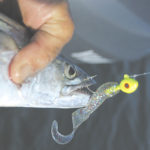
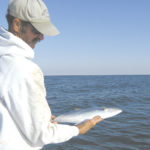
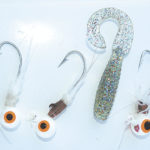
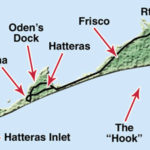
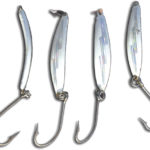



Be the first to comment